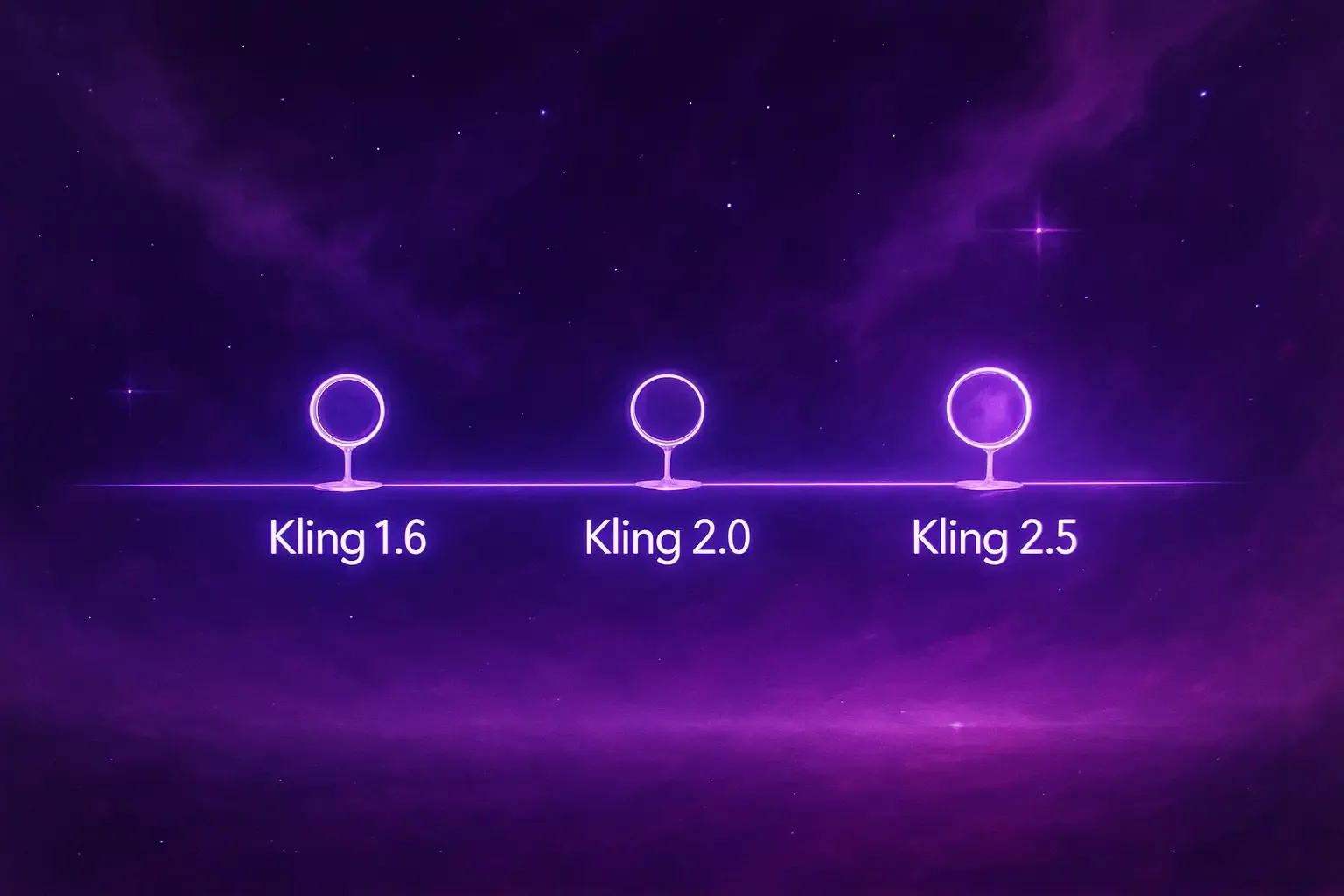Kling 2.5 vs 2.0 vs 1.6 Comparison: Which Model Really Delivers?
If AI video had a family album, Kling 1.6 would be the scrappy kid with big ideas, 2.0 the teenager starting to find its rhythm, and 2.5 the adult who finally gets taken seriously at dinner parties. Wondering how a head-to-head Kling 2.5 vs 2.0 vs 1.6 comparison plays out? Let’s take a look.
The Kling Dynasty: A Quick Trip Down Memory Lane
Before we stack the generations side by side, a little context is crucial. The Kling series, hailing from the labs of Kuaishou Technology, didn't just appear out of nowhere in a flash of hype. They've been steadily, quietly, reliably improving, and that's a virtue in a world of fickle AI models.
The early days of Kling, around version 1.0 and 1.1, were all about proving the concept. Could AI, in theory, even turn text into watchable video? The answer, at the time, was a tentative "maybe." Then came the leap to 1.6, a pivotal update. The model's capacity to translate text into video was suddenly much more robust and impressive.
Kling 1.6 Standard
This was where Kling began to turn heads. Subsequent iterations, 2.0 and 2.1, were about refinement. Kling honed its understanding of prompts, significantly improved its ability to generate longer, more coherent scenes, and smoothed out some of the rough edges in terms of fluidity.
Kling 2.0 Master
This steady evolution is one of the strengths of the Kling lineage. They've avoided the boom-and-bust cycle of some flashier competitors. They're built on a foundation of consistent progress, and Kling 2.5 is the latest expression of that philosophy. It promises even better camera control and prompt following, as well as improved character microexpressions and shadows.
Kling 2.5 Turbo Pro
Check out our introduction to Kling 2.5 for more details about this groundbreaking model!
The Test: One Prompt, Three King Generations
Side-by-side comparisons are where the real story shows. To get a fair look at how far Kling has come, we gave the same set of carefully chosen prompts to Kling 1.6 Standard, 2.0 Master, and 2.5 Turbo Pro.
Cinematic Atmosphere
First, the mood test. Can a model create the kind of immersive, film-like environment that feels more like cinema than simulation?
The prompt:
A cinematic wide shot of a man walking through neon-lit Tokyo streets at night. The camera slowly tracks forward from behind, capturing reflections of neon signs on wet pavement. Soft rain falls, glistening on his black leather jacket. Moody, film-like atmosphere with lens flares and natural motion blur.
Kling 1.6 Standard
Kling 2.0 Master
Kling 2.5 Turbo Pro
- 1.6 and 2.0 both delivered attractive results: colorful, atmospheric, with the right basic mood. But there’s a flatness to the textures, a plastic sheen that makes the clip feel more like a video game on high settings than a film. The rain looks nice, but not quite believable.
- 2.5 is in a different league. Textures carry grit and depth, rain actually clings to clothes and ripples across puddles, and the fog adds cinematic weight. This isn’t just atmospheric. It looks like a shot lifted from a high-budget movie.
Anime Style
Anime has a strict visual language. Many AI models stumble here, either by producing something too flat or by drifting toward realism. This prompt tested whether Kling could stay true to the medium.
The prompt:
Japanese anime style. A girl with long flowing hair stands on a windy hilltop, outlined against a pastel sky. Cherry blossoms swirl in the breeze, catching in her hair. The camera begins with a wide establishing shot, then slowly zooms in, capturing her serene expression with lifelike emotional depth. Soft vibrant colors — pink, light blue, white — evoke beauty and melancholy.
Kling 1.6 Standard
Kling 2.0 Master
Kling 2.5 Turbo Pro
- 1.6 video ended up looking more like a static anime illustration being slowly zoomed in on than a true animated sequence. Pretty, but lacking fluidity or focus.
- 2.0 offered a clear improvement, with smoother motion, but it leaned into a more realistic “anime-inspired” style rather than the classic aesthetic we would have expected.
- 2.5 is where it clicks. The wind flows naturally through the hair, petals swirl with believable motion, the zoom feels cinematic, and the style lands squarely in “classic anime” territory, just at a very high quality.
Realistic physics
Here we raise the difficulty. What looks simple to us (a ball rolling, a glass tipping over, fabric folding) often turns into chaos on screen. It’s the kind of test that separates a model that looks pretty from one that actually feels real.
The prompt:
A polished marble ball rolling down a grand stone staircase. The camera follows dynamically from the side as the ball bounces step to step. Each impact produces natural echoes, light shifts, and reflections across its glossy surface. Subtle shadows and realistic gravity convey hypnotic, lifelike motion.
Kling 1.6 Standard
Kling 2.0 Master
Kling 2.5 Turbo Pro
- 1.6 and 2.0 produced visually beautiful clips (detailed marble, ornate stone steps) but the ball itself moves in strange, unnatural ways, sometimes veering or bouncing at impossible angles. A clear reminder of how tricky physics once was for AI models.
- Meanwhile, 2.5 nailed it. The ball follows gravity, bouncing step by step with weight and inertia that feel authentic. Light plays across its surface with stunning realism. What used to be one of AI’s Achilles’ heels now looks effortless.
Emotional Expression
Finally, the human factor. Great lighting and smooth motion don’t matter if your characters emote like mannequins. Could Kling capture a feeling as specific as deep, wistful sorrow?
The prompt:
An intimate, dramatic close-up of an elderly man's face, illuminated only by the warm, flickering light of a fireplace. He is looking down at a photo album in his hands. A wistful smile touches his lips, but his eyes are filled with a deep, nostalgic sadness, and are glistening with tears. The firelight casts soft, dancing shadows across his wrinkled features, highlighting every detail. Hyperrealistic, emotional, cinematic.
Kling 1.6 Standard
Kling 2.0 Master
Kling 2.5 Turbo Pro
- 1.6 sets the scene well enough, with a recognizable elderly face in firelight, but the emotion feels shallow, more like a somber portrait than a story moment.
- 2.0 leans too far toward “happy.” The smile dominates the expression, and the nostalgic sadness in the eyes doesn’t really register. The result feels warmer than the prompt intends.
- 2.5 strikes the right emotional balance. The smile is there, but so is the weight behind it: glistening eyes, subtle sorrow, and microexpressions that make the moment feel genuinely moving.
The Verdict
Kling 1.6 was groundbreaking in its time. Kling 2.0 turned the model into a reliable everyday tool. But Kling 2.5 Turbo Pro is where the series finally feels like it belongs on a proper film set.
The leap in realism and reliability is hard to overstate. Lighting, camera motion, emotional nuance: all the things that once felt “good enough” now feel right. It’s not that 1.6 or 2.0 are obsolete; they’re still capable. But side by side, 2.5 doesn’t just look better, it feels like a different class of model.
Try It Yourself
Don’t just take our word for it. Fire up the Video Generator on getimg.ai, run the same prompt across Kling 1.6, 2.0, and 2.5, and see the difference.
And remember: Kling isn’t the only model at your disposal. You can also try the likes of Google Veo 3 (model with native sound) or Seedance 1.0 Lite (with the ability to upload reference images) to see which one best matches your creative goals.
Because in the end, the best model isn’t always the newest, it’s the one that makes your story click.

